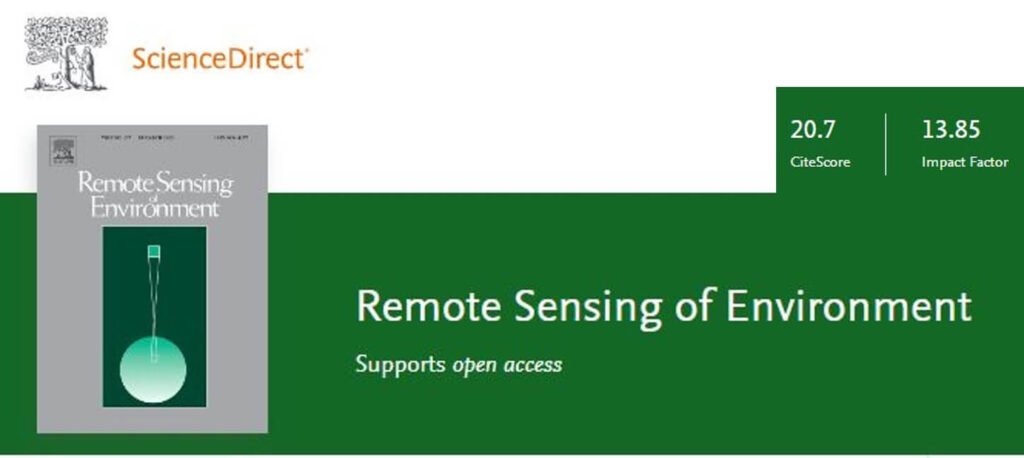Remote Sensing of Environment Journal
Remote Sensing of Environment (RSE) serves the Earth observation community with the publication of results on the theory, science, applications, and technology of studies contributing to advance the science of remote sensing. Thoroughly interdisciplinary, RSE publishes on terrestrial, oceanic and atmospheric sensing. The emphasis of the journal is on biophysical and quantitative approaches to remote sensing at local to global scales and covers a wide range of applications and techniques:

Applications
- Land cover mapping, vegetation species identification and mapping
- Land surface energy and water balance
- Disturbance (fire, insect, harvest)
- Agriculture (crop mapping, yield prediction, phenology, soil properties, management practices)
- Forest and rangeland productivity and inventories
- Ecological applications & Ecosystem services (wetland, biodiversity, habitat, animal population, etc.)
- Urban applications (mapping, energy consumption, population, etc.)
- Terrestrial ecosystem productivity and carbon cycles
- Soil properties (moisture, organic matter, texture, structure, etc.)
- Geological Applications (minerals, landslide, subsidence, geomorphology, earth quake, etc.)
- Hydrology and water resources
- Inland and coastal waters
- Oceanography and marine science
- Cryosphere, mapping and modelling
- Atmospheric science and meteorology
- Snow, ice and glaciers
Techniques & Methods
- Feature extraction from RS images: segmentation and classification, surface structural, biochemical or physiological traits estimation from RS data
- Radiative transfer modelling
- Machine and deep learning for RS data analysis
- RS Data assimilation
- Satellite time series analysis & change detection
- Satellite data fusion (spectral, spatial and temporal)
- Satellite sensor systems characterization including radiometric and geometric calibration
- New remote sensing missions and systems
Original Research Articles should describe important significant new results or methods that will advance the science or application of remote sensing. The main contribution should be the remote sensing component, rather than investigation of an environmental problem in which remote sensing does not play a major role. Papers dealing with single study sites are welcome, although the sites should be representative of broad conditions suitable for drawing conclusions of interest to the international audience of this journal. Studies based on close-range sensing (hand-held, IoT, UAV) are welcome if they show sufficient advances in RS methodology which can be generalized for large-area applications.
Review Articles should provide a thorough review of the current state-of-the-art of an important subject in remote sensing, by providing insights and perspectives on the trends, with a synthesis of previous work beyond literature compilation or bibliometric studies.
Short Communications are intended to publish significant new techniques, data, or results in a timely manner where expansion to a full-length paper may cause delay of their availability to the research or user community (5000 words).
Official Website: https://www.sciencedirect.com/journal/remote-sensing-of-environment
Manuscript Submission: Click Here
Calls for Special Issues:
Close-Range Sensing of Forests
Guest editors: Xinlian Liang, Markus Hollaus, Minna Rautianien, Mathias Disney, Nicholas Coops, Arko Lucieer, Antonio Tommaselli, Peter Surový, Juha Hyyppä – Submission deadline: 30 June 2024
Close-range sensing observes targets at a target-to-sensor distance ranging from a non-contact short range up to several hundred meters. It is a rapidly evolving research area that provides unprecedented capabilities to achieve insights on …
Vegetation monitoring with geostationary satellite observations
Guest editors: Benjamin Dechant, Paul Stoy, Kazuhito Ichii, Jingfeng Xiao, Weile Wang Submission deadline: 15 November 2023
In contrast to polar orbiting satellites, geostationary satellites (e.g., GOES-R, Himawari-8, GK-2A) provide us with sub-hourly data at continental or hemispheric scales. While geostationary satellites were developed for weather-related …
Emerging remote sensing techniques for hydrological applications
Guest editors: Yongqiang Zhang, Di Long, Jiangyuan Zeng, Dongryeol Ryu, Jean-Pierre Wigneron, Qi Huang Submission deadline: 31 October 2023
Remote sensing techniques provide a unique opportunity to understand hydrological flux and state variables including precipitation, evapotranspiration, streamflow, water storage changes, soil moisture, and snow and ice.Remote sensing-based products …

